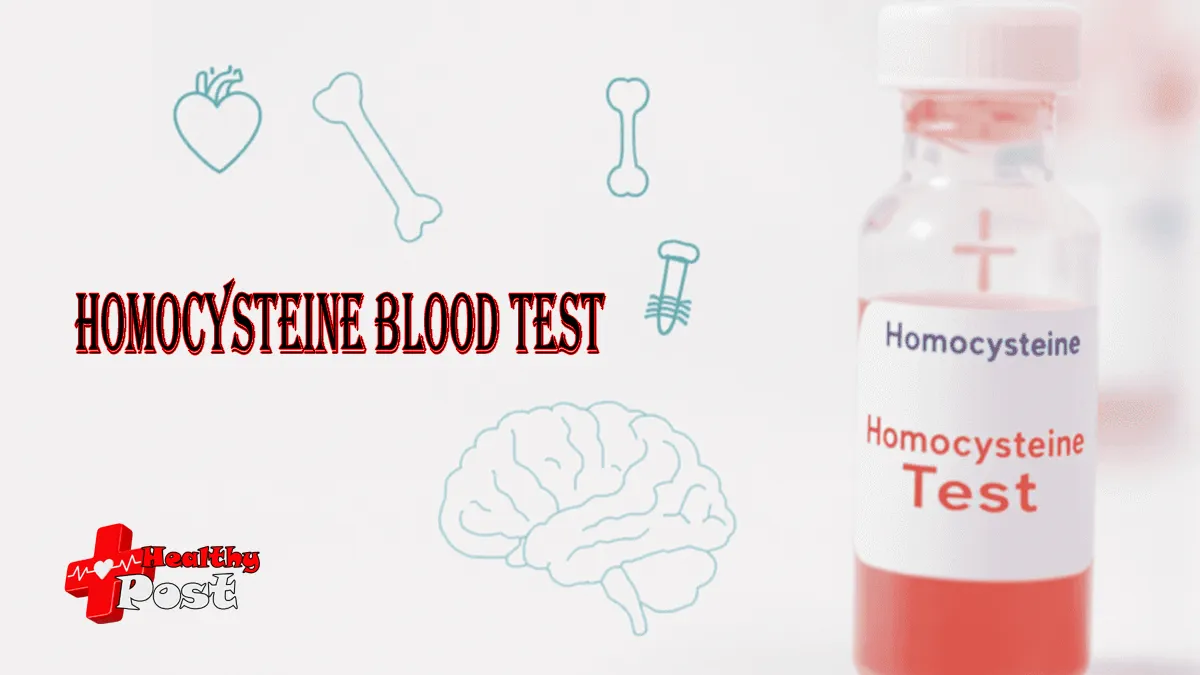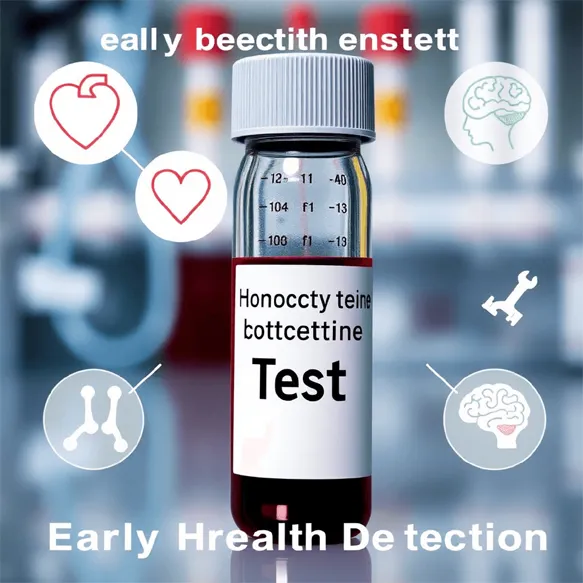
3 Dangerous Health Risks a Homocysteine Blood Test Can Detect Early
A homocysteine blood test serves as a crucial early warning system for potentially life-threatening health conditions. This simple blood test measures homocysteine levels – an amino acid that plays a vital role in protein metabolism within your body.
High levels of homocysteine can signal serious underlying health issues before obvious symptoms appear. Medical research has identified three dangerous health risks linked to elevated homocysteine:
- Cardiovascular Disease: Including heart attacks and strokes
- Osteoporosis: Leading to weakened bones and increased fracture risk
- Neurological Decline: Such as dementia and Alzheimer’s disease
Think of this test as an early detection radar for your health. Just as a smoke detector warns you of fire danger before flames appear, a homocysteine blood test can alert you to potential health threats.
The power of early detection through this test lies in its ability to unveil hidden risks. When health issues are caught early, you gain precious time to take preventive action. This could mean dietary changes, vitamin supplementation, or medical interventions to protect your heart, bones, and brain health.
A single blood test could provide vital insights into your health trajectory – knowledge that might just save your life.
Understanding Homocysteine and its Implications
Homocysteine plays a vital role in your body’s protein synthesis and metabolism. This amino acid emerges during the breakdown of proteins, particularly those rich in methionine like meat and dairy products.
Your body maintains a delicate balance of homocysteine levels through a complex metabolic pathway:
- Protein Breakdown: When you consume protein-rich foods, your body breaks them down into amino acids
- Methionine Conversion: The amino acid methionine transforms into homocysteine
- Recycling Process: Homocysteine converts back to methionine or changes into other beneficial compounds
This intricate process relies heavily on specific B vitamins:
- B12 (cobalamin)
- B6 (pyridoxine)
- B9 (folate)
These vitamins act as essential cofactors in homocysteine metabolism. A deficiency in any of these vitamins can disrupt the normal breakdown process.
When vitamin B levels drop, your body struggles to process homocysteine effectively. Think of it like a factory assembly line – without enough workers (B vitamins), the product (homocysteine) starts piling up.
The relationship between homocysteine and B vitamins creates a two-way street:
- High homocysteine levels can signal vitamin B deficiencies
- Vitamin B deficiencies lead to elevated homocysteine
Your genetic makeup can influence how efficiently your body processes homocysteine. Some people inherit variations in genes that affect homocysteine metabolism, making them more susceptible to elevated levels.
Research shows that certain medications can interfere with B vitamin absorption or homocysteine metabolism:
- Metformin (diabetes medication)
- Proton pump inhibitors
- Some anticonvulsant drugs
Understanding these interactions helps healthcare providers identify potential causes of elevated homocysteine levels and develop targeted treatment strategies.
1. Cardiovascular Disease
High levels of homocysteine can silently threaten your heart health. Studies show that people with high homocysteine levels are at a much greater risk of having heart attacks and strokes.
How Homocysteine Affects Your Arteries
The damage starts in the walls of your arteries. Homocysteine molecules can harm the delicate cells lining your blood vessels. This damage leads to inflammation and creates rough areas where plaque accumulates.
Here’s how the process of arterial damage works:
- Injured vessel walls become sticky and attract cholesterol particles
- White blood cells rush to repair the damage
- Inflammation increases as more cells gather
- Plaque formations grow larger
- Blood vessels narrow and harden
This condition, known as atherosclerosis, restricts blood flow to important organs. As a result, your heart has to work harder to pump blood through these narrowed arteries, leading to higher blood pressure and strain on the heart.
The Clotting Connection
High levels of homocysteine also make your blood more prone to clotting. This amino acid activates platelets and clotting factors while reducing natural mechanisms that prevent clots from forming.
Blood clots pose two major risks to your cardiovascular system:
- Clots can block already-narrowed arteries
- Pieces of clots can break off and travel to other parts of the body
When clots obstruct blood flow to the heart, they trigger heart attacks. If they reach the brain, they cause strokes.
The Importance of Monitoring Homocysteine Levels
Research suggests that for every 5 μmol/L increase in homocysteine levels, the risk of heart disease goes up by 20%. This risk doubles for individuals with levels exceeding 15 μmol/L.
A simple blood test can measure your homocysteine levels and help identify this cardiovascular risk before any symptoms appear. Early detection allows for preventive measures such as dietary changes, B-vitamin supplementation, and medical monitoring.
Understanding how homocysteine affects your arteries and increases clotting is crucial in assessing your risk for cardiovascular events. By keeping track of your homocysteine levels, you gain valuable insights into the factors that contribute to your heart health. For more detailed information on various aspects related to heart health, you may refer to this comprehensive resource on Cardiovascular Disease.
2. Osteoporosis
Research reveals a significant connection between elevated homocysteine levels and bone health deterioration. High homocysteine concentrations interfere with the natural bone remodeling process.
A homocysteine blood test can detect early warning signs of potential bone density loss. Studies show individuals with higher homocysteine levels face up to a 200% increased risk of bone fractures.
The impact of elevated homocysteine on skeletal health manifests through several mechanisms:
- Disruption of collagen cross-linking essential for bone strength
- Interference with bone mineralization processes
- Increased activity of bone-resorbing cells
- Reduced bone formation rates
- Compromised bone matrix quality
Women post-menopause face heightened risks when homocysteine levels rise above normal ranges. The combination of hormonal changes and elevated homocysteine creates a perfect storm for rapid bone density loss.
Recent clinical data highlights concerning patterns in bone structure changes:
- Trabecular bone thinning
- Reduced mineral content
- Increased porosity
- Compromised structural integrity
- Higher susceptibility to fractures
The skeletal system requires specific nutrients to maintain optimal bone density. High homocysteine levels often indicate deficiencies in these crucial nutrients:
- Vitamin B12
- Folate
- Vitamin B6
Early detection through homocysteine testing enables proactive intervention strategies. Medical professionals can implement targeted treatments to protect bone health before significant density loss occurs.
3. Neurological Decline
High levels of homocysteine can have a negative impact on brain health, leading to cognitive decline. Research has shown that elevated homocysteine levels are associated with an increased risk of neurodegenerative diseases, particularly Alzheimer’s disease and dementia.
A blood test measuring homocysteine levels can provide important information about potential neurological risks through several key mechanisms:
- Blood-Brain Barrier Disruption: High homocysteine levels can damage the protective barrier that separates the blood from the brain, allowing harmful substances to enter brain tissue.
- Oxidative Stress: Elevated homocysteine levels can lead to the formation of free radicals, which can damage brain cells and accelerate aging.
- Inflammation: Excessive homocysteine can trigger inflammatory responses that harm the connections between neurons.
- Beta-Amyloid Formation: Homocysteine may promote the accumulation of toxic proteins associated with Alzheimer’s disease.
Study
Studies have found that individuals with high homocysteine levels are at a higher risk for developing Alzheimer’s disease, experience faster decline in memory and processing speed, have increased rates of brain shrinkage, and are more likely to develop early-onset dementia.
Brain imaging studies have shown that elevated homocysteine levels are linked to reduced brain volume and changes in white matter. These structural changes can manifest as memory problems, difficulty concentrating, slower thinking speed, decreased problem-solving ability, and alterations in mood and behavior.
The connection between homocysteine and brain health underscores the importance of vitamin B12. This essential nutrient plays a crucial role in maintaining the protective coverings around nerve fibers (myelin sheaths) that allow for proper communication between brain cells.
By detecting high homocysteine levels early through testing, interventions can be implemented to potentially slow down cognitive decline. Identifying elevated levels may also lead to further investigation into underlying deficiencies or metabolic issues affecting brain function.
Research suggests that lowering homocysteine levels through B-vitamin supplementation may help preserve cognitive function. This protective effect appears to be strongest when intervention occurs before significant neurological symptoms arise.
Diagnosing Health Risks through a Homocysteine Blood Test
A homocysteine blood test is an important tool for finding out if someone has a vitamin B deficiency or a genetic disorder.
How the Test Works
The test needs a small sample of blood, usually taken in the morning after the person hasn’t eaten for 8-12 hours. Here’s what the normal results look like:
- For adults: 4-15 micromoles per liter (µmol/L)
- For children: 5-12 µmol/L
- For pregnant women: 6-14 µmol/L
What High Results Might Mean
If the results are higher than these ranges, it could mean:
- Vitamin B12 Deficiency: Levels greater than 15 µmol/L suggest not enough B12
- Folate Deficiency: Elevated levels point to inadequate folic acid
- Genetic Disorders: Extremely high levels (greater than 50 µmol/L) may indicate homocystinuria
Why Combining Tests is Beneficial
The test becomes even more useful when used alongside other tests:
- Methylmalonic acid levels: This test confirms if there’s a B12 deficiency
- Serum folate tests: These tests validate the status of folate in the body
- Genetic screening: This identifies any inherited metabolic disorders
Who Should Consider This Test?
Doctors often suggest this test for patients who have:
- A family history of heart disease
- Unexplained issues with bones
- Early decline in cognitive abilities
- Ongoing tiredness or weakness
How Doctors Use These Results
The results from the homocysteine blood test assist doctors in creating specific treatment plans, which may include vitamin supplements or changes in diet based on particular deficiencies found.
Assessing Heart Attack Risk with a Homocysteine Blood Test
A homocysteine blood test serves as a crucial tool in evaluating heart attack risk, particularly for individuals with existing cardiovascular concerns. High homocysteine levels act as a significant warning sign for potential cardiovascular events.
Your healthcare provider might recommend this test if you have:
- Family history of heart disease
- High blood pressure
- Elevated cholesterol levels
- Diabetes
- Smoking habits
The test results create a comprehensive risk profile when combined with other cardiovascular markers:
- Lipid Panel: Cholesterol and triglyceride measurements
- Blood Pressure Readings: Systolic and diastolic values
- Blood Sugar Levels: Diabetes indicators
- C-Reactive Protein: Inflammation markers
Research indicates that homocysteine levels above 15 µmol/L can double the risk of heart attack. This risk multiplies when paired with other cardiovascular risk factors.
A study of 1,000 patients revealed:
“Individuals with elevated homocysteine levels showed a 3x higher likelihood of experiencing a cardiac event within 5 years”
The test helps identify silent cardiovascular disease progression before symptoms appear. This early detection enables preventive measures through lifestyle modifications and medical interventions.
Your doctor can use these results to create a personalized treatment strategy, which might include:
- Vitamin B supplementation
- Diet modifications
- Exercise recommendations
- Medication adjustments
Symptoms of Vitamin B Deficiencies to Watch Out For
Recognizing vitamin B deficiency symptoms helps identify potential homocysteine-related health risks early. Your body sends clear signals when B vitamin levels drop too low.
Physical Warning Signs:
- Unexplained fatigue and weakness
- Persistent dizziness or lightheadedness
- Frequent headaches
- Pale or jaundiced skin
- Shortness of breath
- Muscle weakness
Neurological Indicators:
- Difficulty with balance and coordination
- Memory problems
- Depression or mood changes
- Pins and needles sensations
- Vision changes
Digestive and Oral Health:
- Smooth, red tongue
- Mouth ulcers
- Loss of appetite
- Digestive issues
- Unexplained weight loss
Sleep and Energy Patterns:
- Insomnia
- Daytime drowsiness
- Brain fog
- Reduced physical stamina
These symptoms can develop gradually, making them easy to dismiss or attribute to other causes. A homocysteine blood test provides clarity when multiple symptoms appear.
B12 deficiency creates distinct warning signs. Numbness in hands and feet often signals low B12 levels. Some people experience electric shock sensations along their arms or legs.
Folic acid deficiency brings its own red flags. Women might notice changes in their menstrual cycles. Gray hair appearing prematurely points to possible folate issues.
A blood test becomes essential when these symptoms persist. Early detection through testing allows for timely intervention before serious health complications develop.

Managing Elevated Homocysteine Levels for Better Health Outcomes
A balanced diet rich in B vitamins plays a crucial role in maintaining healthy homocysteine levels. Here’s a comprehensive approach to managing elevated homocysteine through nutrition:
Key Food Sources of B Vitamins:
- Leafy greens – spinach, kale, collard greens
- Legumes – lentils, chickpeas, black beans
- Whole grains – brown rice, quinoa, oats
- Animal proteins – fish, poultry, lean meats
- Dairy products – yogurt, milk, cheese
- Seeds and nuts – sunflower seeds, almonds
Lifestyle Modifications:
- Regular physical activity
- Stress management techniques
- Limited alcohol consumption
- Smoking cessation
Supplementation Options:
- B12 supplements (under medical supervision)
- Folic acid supplements
- B-complex vitamins
A healthcare provider may recommend specific dosages based on individual homocysteine levels. Regular monitoring through blood tests helps track progress and adjust treatment plans.
Some people might need additional interventions beyond dietary changes. Genetic factors, medications, or underlying health conditions can affect homocysteine metabolism and require personalized treatment approaches.
The combination of proper nutrition, lifestyle changes, and medical supervision creates an effective strategy for managing elevated homocysteine levels and reducing associated health risks. It’s also essential to consider these factors as part of a broader approach to healthy aging, as they can significantly influence overall health outcomes in later years.
Conclusion
A homocysteine blood test is a powerful tool for maintaining your health. This simple screening can detect three serious health risks – cardiovascular disease, osteoporosis, and neurological decline – before they become major issues.
Your health monitoring routine deserves this important addition. The test provides crucial insights into your body’s vitamin B levels and metabolism functioning. These insights enable early intervention through dietary changes or medical treatment.
Take charge of your health today:
- Request a homocysteine blood test during your next check-up
- Monitor your vitamin B intake through diet and supplements
- Track any symptoms that might indicate vitamin deficiencies
- Share your family health history with your healthcare provider
Your proactive approach to health screening could prevent life-changing conditions. A homocysteine blood test offers valuable information about your health status – information that could make the difference between prevention and treatment.
Don’t wait for symptoms to appear. Schedule your homocysteine blood test and gain peace of mind about your health status.
FAQs (Frequently Asked Questions)
What is a homocysteine blood test and why is it important?
A homocysteine blood test measures the level of homocysteine in your blood, an amino acid produced during protein metabolism. This test is important because elevated homocysteine levels can indicate early risks for dangerous health conditions such as cardiovascular disease, osteoporosis, and neurological decline, enabling timely prevention and management.
How are elevated homocysteine levels linked to vitamin B deficiencies?
Elevated homocysteine levels often result from deficiencies in vitamin B12 and folate (vitamin B9), which are crucial for breaking down homocysteine in the body. When these vitamins are deficient, homocysteine accumulates, increasing health risks.
Which dangerous health risks can a homocysteine blood test detect early?
A homocysteine blood test can detect early signs of three major health risks: cardiovascular disease (including heart attack and stroke), osteoporosis (due to decreased bone density), and neurological decline (such as Alzheimer’s disease and dementia). Early detection allows for better prevention and management strategies.
How does high homocysteine contribute to cardiovascular disease?
High homocysteine levels can damage arterial walls, promoting atherosclerosis, and increase the formation of blood clots. These effects elevate the risk of heart attacks and strokes by impairing normal blood flow and causing arterial blockages.
What symptoms might indicate vitamin B deficiencies related to high homocysteine?
Common symptoms of vitamin B12 or folate deficiency include dizziness, fatigue, and headaches. Recognizing these signs early can prompt testing and treatment to reduce elevated homocysteine levels and associated health risks.
How can elevated homocysteine levels be managed for better health outcomes?
Managing elevated homocysteine involves maintaining a balanced diet rich in B vitamins—particularly B12 and folate—to support proper metabolism. Regular monitoring through a homocysteine blood test can guide dietary adjustments and supplementation to reduce risks linked to high homocysteine.

